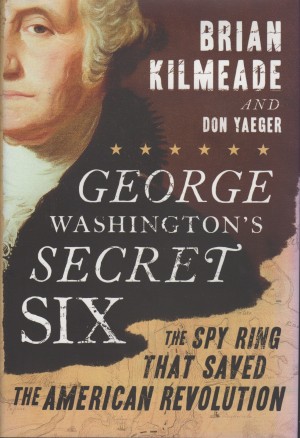
George Washington’s Secret Six: The Spy Ring that Saved the American Revolution by Brian Kilmeade and Don Yaeger (2013. Sentinel. ISBN 978-1-59523-103-1)
My friends Nancy and Ron don’t always see eye to eye with Rene’ and I when it comes to politics. Like so many Americans these days, we often refrain from discussing the major issues of the day because, well, our friends are Fox News sorts of folks and Rene’ and I are more attuned to MSNBC. Still, for the past twenty years or so, Ron and I have bought each other books for Christmas. And generally, though not always, we buy non-fiction biographies or histories that engage and enlighten. That’s how this book came into my hands: Ron wrapped it up in his traditional Christmas wrapping especially selected for his liberal friend (the silver foil of potato chip bags cleaned of crumbs and turned inside out) and handed it to me during Christmas 2014. It took me a year to work down my reading stack to this slender volume. Here’s what I have to report.
Despite the endorsements on the rear jacket (from literary luminaries ranging from Donald Rumsfeld to Donald Trump), this book doesn’t, as the blurb from Karl Rove states, come close to being a “rollicking read.” While the narrative contains some interesting excerpts from letters written by the Culper Spy Ring stationed in and around New York City to their commander-in-chief, General George Washington, and letters from Washington to the leader of the ring, Major Benjamin Talmadge, the authors’ collective choice to invent dialogue and thoughts attributable to Washington and his spies in what seems, at first blush, to be a non-fiction historical account of actual events, clouds the veracity and accuracy of the story. Better for Kilmeade and Yaeger to have made a choice, like Nathan Hale does early in the book, to serve only one master: Either write the story as a novel and include dialogue and emotional content that could be attributed to the stars of the story, or write a straight historical narrative that sticks to what is known about the Culper Ring. Trying to write, what in essence, is a print version of a docudrama, does the story of the brave men and the one woman who risked their lives for their ideals an injustice. I also found the descriptions of the events that lead to the “success” of the spies and the authors’ view of their importance to the Patriots’ ultimate victory at Yorktown overplayed and lacking historical support, at least as contained in this volume. There is cause, there is effect, but there is nothing linking the two by way of facts or information that seems compelling enough to sustain the premise that the Secret Six offered up anything of note that “saved” the Revolution.
The writing was crisp and succinct but tended towards the elementary. It’s as if, in addition to being perplexed as to whether the book should be a novel or accurate history, the authors couldn’t decide whether the book was meant for adults or a juvenile audience. In sum, I learned a bit about the spies that aided Washington during the war that created our nation but, aside from the narratives about hero Nathan Hale and traitor Benedict Arnold, I found very little insightful or compelling in this read.
2 and 1/2 stars out of 5. Don’t waste your money: Watch “Turn: Washington’s Spies” on AMC for a more accurate and exciting retelling of this piece of American history. (More at: https://www.historians.org/publications-and-directories/perspectives-on-history/april-2014/the-revolution-takes-a-turn. Professor Eastman suggests Washington’s Spies: The Story of America’s First Spy Ring (2006) by Alexander Rose as the source of the history behind the series; not the vague and sometimes confusing book that is the subject of this review. You can also find out more about the series at: http://www.amc.com/shows/turn.)
Peace.
Mark


